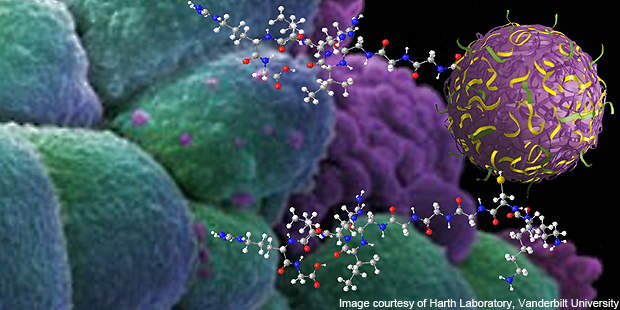
Drug delivery technologies are coming of age and are attracting major investment. A striking recent example is the $1.1bn deal between Swiss pharmaceutical giant Roche and Aileron Therapeutics to develop treatments using ‘stapled peptides’ to target previously ‘undruggable’ proteins.
A peptide consists of two or more amino acids (the building blocks of proteins) that are chemically linked to each other. Massachusetts-based Aileron’s technology involves connecting, or ‘stapling’, two amino acids by mimicking the structure at the interface of many protein-protein interactions. The resulting peptides combine high stability, meaning that they do not break apart too easily, with the ability to cross cell membranes to hit cellular targets.
Potential benefits
Overcoming barriers created by the body is a major imperative.
There is an increasing diversity of compounds from which patients can benefit, but these are of little use if they cannot be readily absorbed by the body.
Effective targeting is also an important issue. It has been estimated that about 99% of medicinal targets do not reach their targets, with many drugs staying within the body – particularly problematic with toxic substances.
How well do you really know your competitors?
Access the most comprehensive Company Profiles on the market, powered by GlobalData. Save hours of research. Gain competitive edge.

Thank you!
Your download email will arrive shortly
Not ready to buy yet? Download a free sample
We are confident about the unique quality of our Company Profiles. However, we want you to make the most beneficial decision for your business, so we offer a free sample that you can download by submitting the below form
By GlobalDataOther key considerations include minimising patient discomfort, precise control of dosage and enabling administration in less specialist environments or by patients themselves.
With all this potential to develop new solutions, the method of delivery is increasingly being considered at the outset of drug development rather than simply as product enhancement.
This potential also explains why organisations are willing to put significant investment into these technologies, including partnerships with and indeed the purchase of other market players with an expertise in these areas.
Nanotechnology solutions
Much investment will continue to be directed towards solutions based on nanotechnology, with such techniques often holding the key to targeting and reaching affected cells with high levels of accuracy.
In a recent development, scientists at the US-based Georgia Institute of Technology have developed a method where they are able to blast temporary holes in cell membranes, allowing therapeutic drug molecules to enter the cell.
Carbon nanoparticles are injected into fluid floating around cancer cells, which are then heated using a laser. The heat creates gas bubbles, and when these burst a hole is blown in the cell membrane. Drug molecules that are floating in the fluid around the cancer cells can also then enter them.
Meanwhile, scientists at Vanderbilt University in Nashville have been using nanosponges to target tumours. Tiny sponges that are about the size of a virus are filled with a drug and attached to special chemical linkers that bond preferentially to a feature found only on the surface of tumour cells.
Once injected into the body, the sponges circulate until they encounter the surface of a tumour cell where they stick on the surface and begin to release the drug gradually.
Beyond injection
Biopharmaceuticals are derived from or based on living sources and may be composed of living cells, tissues, sugars, proteins or nucleic acids.
They have greatly improved the treatment of a number of diseases that are traditionally difficult to tackle, including autoimmune and inflammatory disorders and cancer.
However, because they are large, complex and delicate, they are difficult to get into the circulatory system, meaning that they are most commonly administered through injection or intravenous infusion – effective but not particularly pleasant for patients.
Several companies in the industry are working on making oral drug delivery a practical option in such cases. Unigene Laboratories has developed an oral peptide drug delivery technology called EnteriPep that utilises several mechanisms to ensure effective absorption.
This is currently being applied in the development of an oral formulation of salmon calcitonin that is in Phase III clinical trials for the treatment of osteoporosis.
Another promising drug delivery route for biopharmaceuticals is through the skin. Transdermal drug delivery is convenient and allows for a controlled release of medication.
It bypasses the gastrointestinal tract, eliminating degradation by digestive enzymes. However, the skin itself acts as a barrier inhibiting the amount and size of molecules that can be delivered this way.
Altea Therapeutics has developed the PassPort Transdermal Delivery System which consists of a disposable, one-use patch and a reusable applicator.
The applicator uses pulses of electrical energy to create micro-channels in the surface of the skin through which the bio-pharmaceuticals can pass.
The company is working with a number of partners on various applications, including treatments for type 2 diabetes and deep vein thrombosis.
There are very significant risks involved in developing new delivery methods, including disappointing results, regulatory problems and greater take-up for competing technologies, coupled with the major investment involved.
However, organisations with an eye to the future are willing to embrace these challenges, because they know that innovation in this area is central to the achievement of new and significant benefits for patients and healthcare providers.







